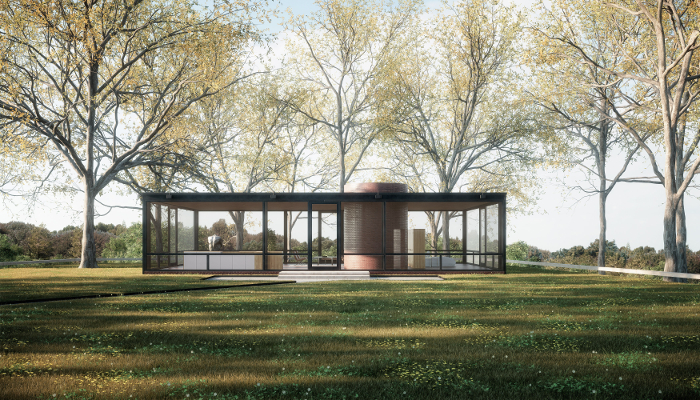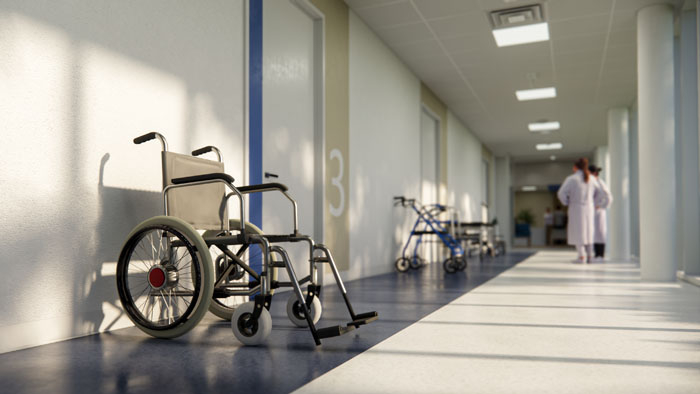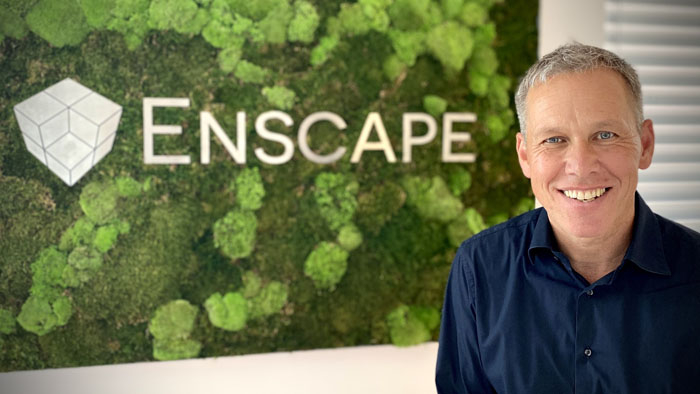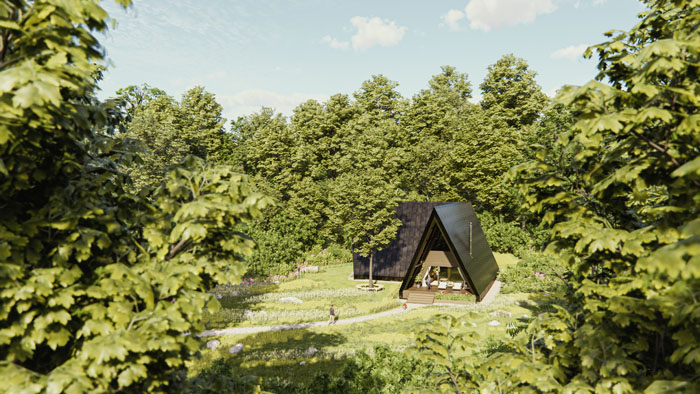Greg Corke caught up with Enscape’s new CEO, Christian Lang, to talk BIM objects, issue tracking, RTX ray tracing, collaborative VR, point clouds and what the future holds for the popular real time visualisation tool
Greg Corke: When we first looked at Enscape in 2016, the quality of the rendering was good, but nothing special. Now it’s gone to quite amazing levels and you also have Nvidia RTX ray trace rendering technology built in. How has that changed the way that your customers are using the software in their workflow?
Christian Lang: I personally believe it’s not really changing the way the customers are using the software. One of the key strengths of Enscape is the visual quality, yes, but it’s much more about the integration into CAD and BIM, and it’s much more about the ease of use and creating high-performance workflows. And this integration into BIM has never changed. So yes, you’re right there is now a much higher quality when it comes to the visual look of the graphics, but that’s just one piece of the value we offer.
GC: We’ve heard that some architects are now using Enscape to do visualisations that previously they may have passed onto a viz specialist. So, I guess what I mean is have you found that your customers are now bypassing other rendering tools and your architects are becoming more hands-on with visualisation, for presentations and stuff like that? And where does that leave the traditional arch viz ray trace rendering tools?
CL: Definitely. As you were saying, in many, many cases the visual quality is more than good enough for what the architects need when they present to a customer, when they use it for the design development, for design reviews, absolutely. However, I think there is still a kind of a legitimation for other renderers, offline renders.
There are things we don’t do at Enscape. We don’t do dynamic smoke simulation, or we don’t do stained glass shadows, things like that. Who knows, maybe we will do sometime in the future, but clearly not today. And when it really comes to the perfect marketing shots, this one picture that you need, I think this is something they will always use some other tools to make it almost perfect.
However, I think the gap between what we have today and what they offer is closing. Will we be able to go to one hundred percent? Most likely not. I think there will always be space for some very, very specific things that we don’t do, but for most rendering, especially in early design, it is exactly what architects need.
GC: Since the 2.7 release, objects can be selected in Enscape and their associated BIM information displayed. This is great, because I know your customers have been asking for that for ages. Now you’ve delivered, what feedback have you had and how has it changed the way your customers use the software?
CL: The feedback we are getting is, it’s a good first step. However, customers always want more. They now want to have it in the standalone version, they want to have it in VR. So, it’s the first step into that direction, and more to come.
GC: So, you can only access the BIM information if you’re connected to your BIM authoring tool?
CL: Correct, you have to have the connection.
GC: Now you’re on to version 2.8 and one of the most exciting developments is this new focus on design /review. You now have tools for annotation and issue resolution through the integration with cloud-based BIM collaboration platform BIM Track. This takes Enscape beyond its core remit of real-time rendering. Can you explain how this works?
CL: The new annotation feature allows you to store issue trackers in the Enscape scene. So you can set states, you leave comments there for other team members, you’re getting an immediate overview of the progress in the project. The Enscape rendering is automatically added to the annotation. The discussion points are saved in the CAD project, then it can be exported in BCF [BIM collaboration format] or it can be synced with BIM Track.
And especially this last part. That’s where the information throughout the whole design, you can leverage that full feature set and the interface of BIM Track with your Enscape visualisation without the need to export or import files.
What’s interesting about [the integration with] BIM track is that it really provides for the industry (for the first time ever I think) a collaborative workflow in a fully photorealistic rendered model. So, you can see light and materials and textures and get a feel for the design that you just couldn’t have prior to 2.8.


GC: Enscape loves powerful GPUs…
CL: [laughing] Show me any real time visualisation software that does not love powerful GPUs.
GC: [smiling] That’s not specific to Enscape, of course, but because the GPU requirements of Revit are so small, has that been a barrier to adoption? For you to get Enscape on every single desk of every single Revit user, for example, they’re going have to update their hardware.
CL: Not that I’m aware of. I think it’s exactly the opposite. I think that the customers appreciate that with Enscape they can even use not the highest performing hardware. Enscape is already optimised in a really good way that it can be used on a slower machine. And if they really want to have the high, high visual graphics, then maybe it’s just one machine they have, where they render the final kind of image.

GC: Enscape was a pioneer of architectural VR. It was amazing how it was so seamless, while all these other tools were going through this long process of exporting and optimising BIM models. How are your customers using VR, and how has that changed over the years?
CL: I can just talk about one customer I met, where I had this specific conversation two weeks ago. The customer told me that they are using it in the same way they would do a design review or a design development session. So, it’s kind of integrated in their design meetings, where they have questions or they want to show something if they have a topic they want to discuss, then they integrate it into that, but it’s not really fundamentally changing the way how they do the design reviews. It’s just another tool that they use.
GC: So, at the moment, people are using it as a solo experience? So, if you were doing a design review in VR, you’d have to literally share a headset to get that done?
CL: Yeah, exactly.
GC: Are there any plans for collaborative VR?
CL: The only answer I have is it’s on our radar. But I think the moment when we can offer something to the customers, and if they can use VR in a collaborative way, I think that can be a game changer when it comes to how they use it in a design meeting. Because that’s then when you also have the chance to involve someone outside of your company, right? Again, we have it on our radar, but obviously I can’t talk more with regards to that.
GC: Because of how easy it is to go from BIM to VR with Enscape, are your customers using it day to day – to literally jump in and out of VR? You’ve got a VR headset on your desk, you’re in the design process, you just want to check something, so you hold the headset up to your head to get better understanding of scale, and then you go ‘right OK, that’s great, or maybe I can change this or change that’. Are your customers using it in that way or is it more for design review?
CL: It’s both. It’s while they are working at their desk, and it’s as part of the design review process. A really interesting story that came out recently about VR in preconstruction, where an architectural office actually invited the fire marshal and the building inspector and health inspector all in, for pre-construction to do their inspections. That’s another use case, beyond design review.
GC: Point clouds seem to be going crazy in AEC at the moment. Some CAD tools support them to various different degrees of capability. Enscape doesn’t at the moment. Is that something that you’re looking at?
CL: Well, the same here, it’s on the radar. [In order to support point clouds] we need to go deep into the core product, so into the programming code and things like that. So, it’s on the radar, absolutely. By the way, we see that as well – point clouds and the explosion of that in AEC is becoming a topic. But we will see how we can support that, if we will support that. Right now, it’s completely open.

GC: What’s Enscape’s long-term vision?
CL: As you can imagine, this is of course a big question. What I can tell you is that, typically, I’m very much ‘outside in’ driven. And this is something that I’ve already figured out here at Enscape where I think we will become better — and this is really listening to our customers and involving the customers much more in the planning of the future of Enscape. And this could even go beyond pure real-time rendering.
But at the end of the day, what we are doing here, we are supporting the workflows of the customer. This needs to become the number one, or rather, this is the number one key theme for Enscape. I would love to become mission critical to customers. In our industry, there are still cases where we are ‘nice to have’ and this is changing slightly, but I think the future of Enscape is definitely in that direction.
If you enjoyed this article, subscribe to our email newsletter or print / PDF magazine for FREE







